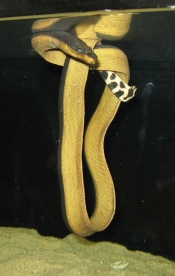
By Miriam Raftery
Photo: Public domain image by Totodu, via Wikipedia
October 18, 2015 (San Diego)—As if mudslides and flash floods aren’t enough to worry about from warming ocean currents that give rise to El Niño weather conditions, now there’s a new concern for beach-goers. A venemous yellow-bellied sea snake has been found on a beach in Oxnard north of Los Angeles, and later returned to the water. A second sighting was also reported, though it's uncertain whether this was the same snake or a second one.
Normally found in warm tropical waters such as those off Australia and Central America, the yellow-bellied sea snake is among the most poisonous snakes in the world. This is the farthest north that one has ever been found. The last sighting was 30 years ago during El Niño conditions– in San Diego County back in 1985. They have also been spotted in San Clemente in 1983 and Los Angeles Bay in 1961.
Like the killer shark in the movie “Jaws,” the vision of swimming sea snakes may make you wonder if it’s best to stay out of the water. The group Heal the Bay advises that there is “no need to panic” over the snake found on the sand in Oxnard. Here's why.
Fortunately, the yellow-bellied sea snake is generally not aggressive toward humans, though you should avoid handling any snake found washed up on the shore. First, because holding one in a tilted position out of water for even a few minutes can kill this rare visitor to California, since the snakes can’t maintain an even blood pressure outside of the water. Second, if handled the snake is more apt to bite—and the venom can be deadly.
So what should you do if you spot a yellow-bellied sea snake?
 If it’s stranded on a beach, call a local wildlife rescue organization. Don’t touch it or attempt to handle it.
If it’s stranded on a beach, call a local wildlife rescue organization. Don’t touch it or attempt to handle it.
The environmental group “Heal the Bay” is asking Californians to report all sightings of the snake, whether on land or in the sea. To reach Heal the Bay, you can contact eric@discoball.com. Take photos and try to get GPS coordinates for the location. Your data could be published in scientific journals.
Here are some fascinating facts about these colorful snakes, which are black on top and yellow on bottom, with a black spotted tail.
The yellow-bellied sea snake lives its entire live in the ocean water., but is unable to move well if washed ashore. In the water, however, it can swim both forwards and backwards. This snake can dive and stay under water for up to three hours, waiting beneath the surface to ambush and eat small fish. It is capable of bursts of speed up to 1 meter per second and when swimming rapidly, it sometimes holds its head upright, out of the water.
Most intriguing, the yellow-bellied sea snake willf actually tie itself into knots, moving the knot along the length of its body to shuck off barnacles that grow on sea snakes—and sheds its skin in the same manner.
Thus far, sightings of yellow-bellied sea snakes in California remain rare—though with climate change, such visitors could become more frequent. They are, in fact, the most widely distributed sea snake species in the world, ranging from Australia to Baja, Mexico.
Now here’s one more sea snake fact to give you chills-- just in time for Halloween.
In some parts of the world, such as the Gulf of Panama, where currents converge, several thousand yellow-bellied sea snakes have been observed congregating around debris slicks in a veritable sea snake convention.
Sources: Los Angeles Times, Slate, Australia Museum, and Herpes California.








Recent comments